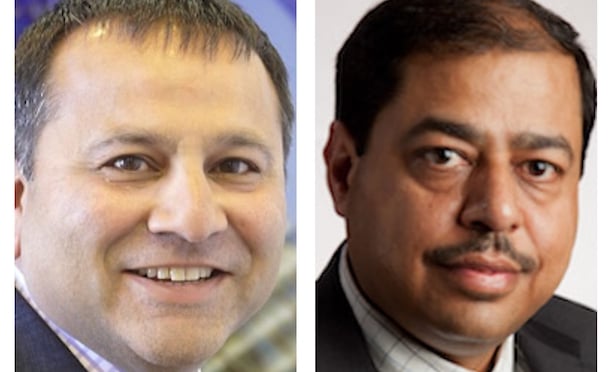 From left: Neil Shah, managing director of RICS in the Americas, Anil Sawhney, director of infrastructure sector for RICS
From left: Neil Shah, managing director of RICS in the Americas, Anil Sawhney, director of infrastructure sector for RICS
Infrastructure in many developed economies was built for a global population of three billion. As the world now approaches nine billion people and cities grow at an unprecedented rate, the infrastructure gap is worsening. More infrastructure is expected to be built in the next 40 years than previously to date, while cities must also maximize performance from existing assets, all to alleviate concerns over resources, instability and resilience.
However, as the US Secretary of Transportation correctly stated in a recent speech, “Everyone gets the importance of infrastructure; the difficulty is how you pay for it.”
Demonstrating Value Across the Asset Lifecycle
In the US, public sector balance sheets are already stretched, and as cities are challenged to drive the investment necessary to support growth, public-private partnerships can help relieve the taxpayer burden and reduce the infrastructure gap.
However, investors need confidence that spending will be impactful and that the professionals building, maintaining and operating assets do so effectively over the entire asset lifecycle. Through the advent of consistent, comparable and transparent cost measurement standards, infrastructure professionals are rising to the challenge of building confidence for private investors and public stakeholders alike, as both groups must demonstrate to constituents that decisions for roads, airports and rail will improve quality of life for years to come.
It is important then to take a longer view of design, construction and operation to demonstrate value for money in all decisions. Making better use of public dollars by delivering projects on time and on budget across the asset lifecycle is critical to that mission of winning investments.
In the US especially, the lack of existing modern, resilient infrastructure imposes further challenges. Resources being shipped from greater distances jostle for space with commuters on clogged roads and rails bound for urban centers, increasing air pollution and transit times. Therefore, it is imperative that investments in infrastructure are broad-based and regional as well. Plans must consider not only current urban needs but the needs of a wider population in an era when growth is outpacing predictions.
Ensuring Everyone Benefits
Urban growth doesn't respect political boundaries. Cities cluster and merge across state and political lines, increasing the complexity of infrastructure investments. The trend should be toward thinking about infrastructure as serving economic zones rather than city or state borders, which enables decision makers to take a wider approach to economic development. Collaboration across political bodies then is key. The Port Authority of New York and New Jersey is a longstanding example of states working together to facilitate development to make a metro area more resilient.
When cities and states work together on infrastructure projects, prosperity spreads not only to urban dwellers but to the broader region. With investments in transit, workers can travel to city centers to take advantage of better-paying jobs while spending their salaries where they live. With investment in ports and airports, goods and people can come and go easily. As regions continue to invest in infrastructure, smaller towns share in the economic benefits from increased connectivity. Considering infrastructure's social value is also essential to this effort, as it provides a holistic appraisal of impacts and can help reduce inequality and environmental degradation.
Taking a Wider View of Infrastructure
This wider view is crucial, as the challenges also don't respect political boundaries. A warmer climate brings increased risk of extreme weather and rising sea levels, with much of the US and world's zones of economic opportunity situated in low-lying areas. By 2030, climate change and natural disasters may cost cities billions each year and could push millions of urban residents into hardship.
Investments in resiliency measures have been slow to date but data forecasting can quantify the value of resiliency features and reinforce the utility of sustainable investing. Experts are building investor trust through, for instance, innovation in technology and data analytics that allow for better mapping of demographic trends and more thorough predictions of climate impact on the built environment. Technology also enables more active control of infrastructure operations and maintenance, adding to its resilience.
While this trend of rapid urbanization shows no signs of slowing, long-view investments in economic zone infrastructure can ensure megacities have access to resources and enable the flow of opportunity and people. Creating the necessary investor confidence in both the public and private sectors is crucial to ensuring US cities close the infrastructure gap.
Neil Shah is the managing director of RICS in the Americas. Neil is responsible for managing RICS' presence in the US, Canada, Latin America and the Caribbean. His focus is to build the RICS brand, through the adoption of standards and growth of the profession.
Anil Sawhney is the director of the Infrastructure sector for RICS. He is involved in the production of the infrastructure sector's body of knowledge, standards, guidance, practice statements, education and training.
The views expressed in this article are the authors' and not those of ALM Real Estate Media Group.
Want to continue reading?
Become a Free ALM Digital Reader.
Once you are an ALM Digital Member, you’ll receive:
- Breaking commercial real estate news and analysis, on-site and via our newsletters and custom alerts
- Educational webcasts, white papers, and ebooks from industry thought leaders
- Critical coverage of the property casualty insurance and financial advisory markets on our other ALM sites, PropertyCasualty360 and ThinkAdvisor
Already have an account? Sign In Now
*May exclude premium content© 2025 ALM Global, LLC, All Rights Reserved. Request academic re-use from www.copyright.com. All other uses, submit a request to [email protected]. For more information visit Asset & Logo Licensing.








